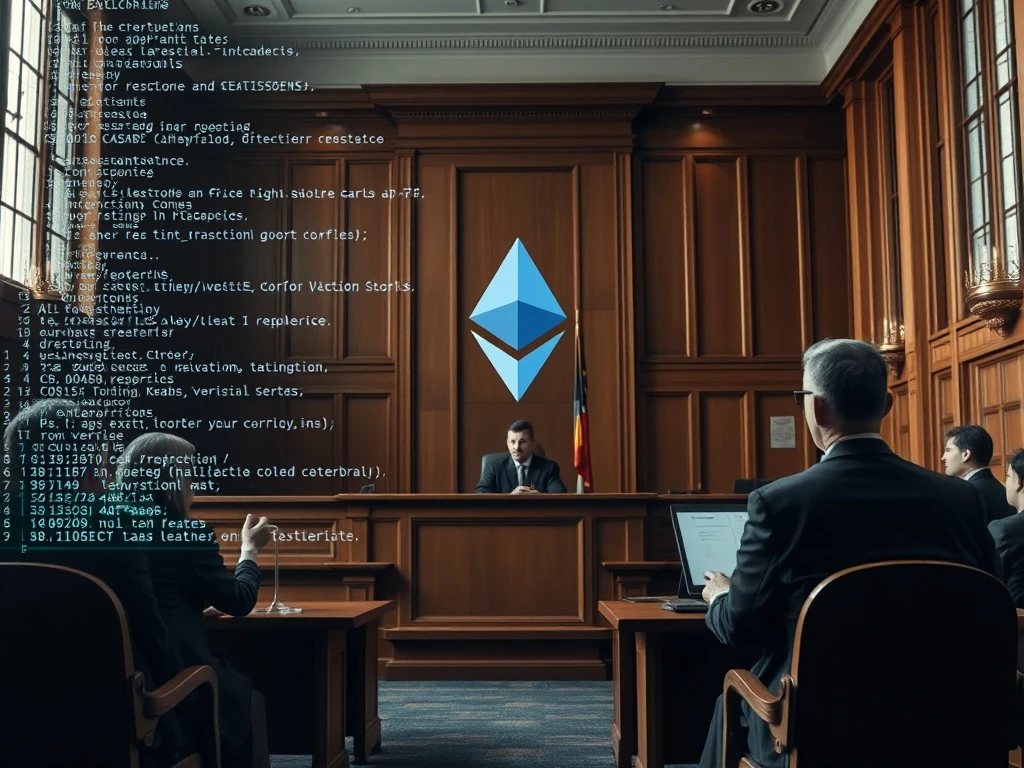Crucial MEV Bot Trial: US Prosecutors Challenge Crypto Policy Arguments

The **MEV bot trial** involving Anton and James Peraire-Bueno has reached a pivotal moment. **US prosecutors** are now strongly objecting to the introduction of broader **crypto policy** arguments. This legal battle could significantly shape the future of digital asset regulation. Indeed, its outcome carries immense weight for the entire crypto ecosystem.
US Prosecutors Object to Broader Crypto Policy Discussions
In a crucial development, **US prosecutors** are pushing back. They oppose efforts to bring wider **crypto policy** discussions into the ongoing case. The trial concerns two brothers. They stand accused of exploiting Ethereum using maximal extractable value (MEV) bots. This objection came in a Tuesday filing. It was submitted within the US District Court for the Southern District of New York. Prosecutors specifically opposed an amicus curiae brief. This brief was filed by **Coin Center**, a prominent cryptocurrency advocacy organization. Prosecutors argue such a brief could encourage a jury to acquit Anton and James Peraire-Bueno. This would undermine the legal process, they claim.
The Peraire-Bueno brothers allegedly orchestrated a $25-million **Ethereum exploit** in April 2023. This exploit reportedly utilized sophisticated MEV bots. The prosecution’s letter to the federal judge highlighted their concerns. They suggested that **Coin Center** should address its digital asset policy concerns to Congress. The courtroom, they argue, is not the appropriate forum for such discussions. “To allow an amicus brief of this type […] is to allow the defendants to argue for nullification and is lawless,” the filing stated. It emphasized that the court’s sole concern is determining guilt based on evidence. Broader policy questions, they assert, do not belong in this arena. This position underscores the government’s focus on the specific criminal charges.
Coin Center’s Amicus Brief and Defense Arguments
The defense team for the Peraire-Bueno brothers quickly responded to the government’s letter. They stated that the **Coin Center** brief offers a “unique perspective.” This perspective, they believe, will greatly assist the Court. It provides crucial context around the prosecutors’ legal theory. Defense lawyers argue that Ethereum users engage in economic activity. Therefore, the government’s theory implies a vast scope of federal criminal liability. Any trading strategy or interaction deviating from blockchain protocol specifications could be criminalized. This interpretation, they contend, is inconsistent with common sense and existing legal precedent. Consequently, the defense views the amicus brief as vital.
Furthermore, the defense highlighted the government’s reluctance. Prosecutors have refused to defend this “breathtaking theory” thus far. This stance underscores the complex legal questions at play. The outcome of this **MEV bot trial** could set significant precedents. These precedents would impact many participants in the digital asset space. The implications extend far beyond the Peraire-Bueno brothers themselves. This is why **Coin Center** felt compelled to weigh in. Their involvement emphasizes the industry’s concern over legal interpretations of blockchain activity.
Unpacking the Ethereum MEV Exploit Mechanism
The criminal case against the Peraire-Bueno brothers commenced on October 15. This was over a year after their indictment. They face serious charges. These include conspiracy to commit wire fraud, money laundering, and conspiracy to receive stolen property. At its core, the case revolves around the brothers’ alleged use of MEV bots. These bots reportedly removed $25 million worth of crypto in 2023. An **Ethereum MEV exploit** happens when a blockchain validator or trader manipulates transaction order. This manipulation occurs within a block. The goal is to gain an unfair profit. This process is often called “sandwiching.”
Maximal Extractable Value (MEV) has become a significant topic in blockchain technology. Data cited in a July report by the European Securities and Markets Authority (ESMA) showed its scale. Ethereum-based MEV revenues totaled about $963 million between December 2022 and January 2025. Profits from these activities reached roughly $417 million. These figures demonstrate the substantial financial incentives involved. The **MEV bot trial** is therefore scrutinizing a highly profitable, yet contentious, practice. It challenges the boundaries of what constitutes legitimate trading versus illicit activity. This distinction is critical for the industry.
Industry Implications and Future of Crypto Policy
Many industry leaders and advocacy organizations closely monitor this **MEV bot trial**. A guilty verdict or specific court decisions could have wide-ranging impacts. These impacts would affect others in the crypto industry. The legal definitions and interpretations emerging from this case are crucial. They could redefine what constitutes a legitimate trading strategy versus a criminal act on a blockchain. This is why the debate over **crypto policy** is so central to the proceedings. The broader community watches for clarity and guidance. Specifically, they seek clarity on how existing laws apply to decentralized systems.
The US government asserts that the brothers “tricked their victims.” They committed a “high-speed bait and switch” to steal crypto. Conversely, defense lawyers argue that the “victims here were sandwich bots.” They claim the Peraire-Buenos simply used a trading strategy. This strategy aimed to extract digital assets. This fundamental disagreement highlights the complexity. It underscores the challenge of applying traditional legal frameworks to novel blockchain mechanics. The outcome will surely influence future **US prosecutors**’ approaches to similar cases. It will also guide the development of future crypto regulations.
The trial entered its 11th day recently. It is expected to continue into November. If found guilty, the brothers could face severe penalties. A judge might sentence them to up to 20 years in prison for each count. This potential outcome underscores the gravity of the charges. It also highlights the urgent need for clear **crypto policy** guidelines. The entire industry awaits the verdict with keen interest. The resolution of this case will undoubtedly set a significant precedent for the digital asset space.










